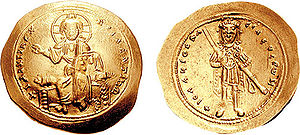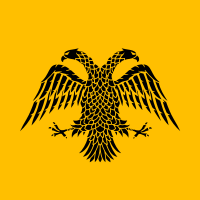- Isaac I Komnenos
-
Isaac I Komnenos
Ισαάκιος A' ΚομνηνόςEmperor of the Byzantine Empire 
Gold histamenon of Isaac I KomnenosReign 5/8 June 1057 – 22 November 1059 Coronation 1 September 1057 Born c. 1007 Died c. 1060–1061
(aged 50–55)Place of death Monastery of Stoudios, Constantinople Predecessor Michael VI Stratiotikos Successor Constantine X Doukas Consort to Catherine of Bulgaria Offspring Manuel Komnenos
Maria KomneneDynasty Komnenoi Father Manuel Erotikos Komnenos Isaac I Komnenos (or Comnenus) (Greek: Ισαάκιος A' Κομνηνός, Isaakios I Komnēnos) (c. 1007[1] – 1061) was Byzantine Emperor from 1057 to 1059, and the first reigning member of the Komnenos dynasty. His brief reign saw an attempt to restore the Byzantine Empire’s military capability and reputation.
Contents
Life
He was the son of Manuel Erotikos Komnenos, the strategos autokrator of the East under Emperor Basil II[2] who in 978 defended Nicaea against Bardas Skleros, and one of his two wives, whose names are unknown, and who on his deathbed in 1020 commended his two surviving sons Isaakios and Ioannes to the emperor's care.[3] Basil had them carefully educated at the monastery of Stoudion, and afterwards advanced them to high official positions. He also had an older son, Nikephoros, who died in 1026, and a daughter, born in 1012 and married around 1031 to Michael Dokeianos, Catepan of Italy, deceased in 1050. It is said that their name was derived from the city of Komne, near Philippopolis,[2] where they were landowners, and that they were of Armenian ancestry from Paphlagonia, which is supported by the use of the name Manuel instead of Emmanouel.
During the disturbed reigns of Basil's seven immediate successors, Isaac by his prudent conduct won the confidence of the army. From 1042 to 1057, he served as commander of the field army in Anatolia. In 1057, after being humiliated by the Emperor Michael VI,[4] he rebelled in Paphlagonia, and joined with the nobles of the capital in a conspiracy against Michael VI.[5] Proclaimed emperor by the army on June 8, 1057, he defeated an imperial army at the Battle of Petroe.[6] A panicked Michael VI attempted to negotiate with the rebels through the famous courtier Michael Psellos, offering to adopt Isaac as his son and to grant him the title of kaisar (Caesar),[7] but his proposals were publicly rejected. Privately Isaac showed himself more open to negotiation, and he was promised the status of co-emperor. However, during the course of these secret negotiations, a riot in favor of Isaac broke out in Constantinople.[7] With Michael VI’s deposition, Patriarch Michael Keroularios crowned Isaac I emperor on September 1, 1057,[1] taking much of the credit for Isaac's acceptance as monarch.[8] His coronation marks the founding of the new dynasty of the Komnenoi.
The first care of the new emperor was to reward his noble partisans with appointments that removed them from Constantinople,[8] and his next was to repair the depleted finances of the empire.[9] He revoked numerous pensions and grants conferred by his predecessors upon idle courtiers, and, meeting the reproach of sacrilege by Michael Keroularios with a decree of exile in 1058,[1] he appropriated a proportion of the revenues of the wealthy monasteries. Isaac's only military expedition was against King Andrew I of Hungary and the Pechenegs, who began to ravage the northern frontiers in 1059.[10] Shortly after this successful campaign, he concluded peace with the Kingdom of Hungary and returned to Constantinople.[11] Here he became very ill, and believed he was dying. He was already deeply shaken after narrowly avoiding being struck by lightning while leaning against a tree on campaign against the Pechenegs, and saw his illness as a sign of God's displeasure.[12] This situation was exploited by the courtiers, led by Michael Psellos,[13] who influenced Isaac to appoint as his successor Constantine Doukas, to the exclusion of his own brother John Komnenos.[14] Isaac abdicated on November 22, 1059, against the wishes of his brother and of his empress Catherine of Bulgaria. Like Isaac, his wife and daughter entered a monastery.[15]
Although he recovered, Isaac Komnenos did not resume the throne, but retired to the monastery of Stoudion and spent the remaining two years of his life as a monk,[12] alternating menial offices with literary studies. His Scholia to the Iliad and other works on the Homeric poems are still extant. He died late in 1060 or early in 1061. Isaac's great aim was to restore the former strict organization of the government,[8] and his reforms, though unpopular with the aristocracy and the clergy, and not understood by the people, certainly contributed to the continued survival of the Byzantine Empire.
Family
He married Catherine (as nun, Xene) of Bulgaria, a daughter of Ivan Vladislav of Bulgaria. They had at least two children:
- Manuel Komnenos, who died before 1059.
- Maria Komnene, a nun.
Sources
Primary Sources
- Michael Psellus, Chronographia.
- Michael Attaleiates, History
Secondary Sources
- Kazhdan, Alexander, ed. (1991), Oxford Dictionary of Byzantium, Oxford University Press, ISBN 978-0-19-504652-6
- Canduci, Alexander (2010), Triumph & Tragedy: The Rise and Fall of Rome's Immortal Emperors, Pier 9, ISBN 978-1741965988
- Norwich, John Julius (1993), Byzantium: The Apogee, Penguin, ISBN 0-14-011448-3
- George Finlay, History of the Byzantine and Greek Empires from 1057–1453, Volume 2, William Blackwood & Sons, 1854
 This article incorporates text from a publication now in the public domain: Chisholm, Hugh, ed (1911). Encyclopædia Britannica (11th ed.). Cambridge University Press.
This article incorporates text from a publication now in the public domain: Chisholm, Hugh, ed (1911). Encyclopædia Britannica (11th ed.). Cambridge University Press.
References
- ^ a b c Kazhdan, pg. 1011
- ^ a b Kazhdan, pg. 1143
- ^ Finlay, pg. 10
- ^ Norwich, pg. 328
- ^ Canduci, pg. 270
- ^ Attaleiates: History 55.7–56.1
- ^ a b Norwich, pg. 332
- ^ a b c Norwich, pg. 333
- ^ Finlay, pg. 11
- ^ Norwich, pg. 335
- ^ Finlay, pg. 14
- ^ a b Canduci, pg. 271
- ^ Kazhdan, pg. 1012
- ^ Norwich, pg. 336
- ^ Finlay, pg. 15
Isaac I KomnenosBorn: c. 1005 Died: 1061Regnal titles Preceded by
Michael VIByzantine Emperor
1057–1059Succeeded by
Constantine XCategories:- 11th-century Byzantine emperors
- Byzantine Armenians
- Komnenos dynasty
- Monarchs who abdicated
- 1000s births
- 1061 deaths
- Orthodox monarchs
- Eastern Orthodox monks
Wikimedia Foundation. 2010.


